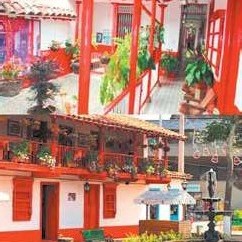Colombian traditional architecture as a passive system of enerfetic exploitation
Main Article Content
Abstract
The architectural tradition of Colombia contains a rich culture not only as a historical witness of a country but also reflects the essence of the principies of sustainability, especially in its residential character. AII these strategies were innate to the needs of its people who knew how to adapt to their natural environment while colonizing space. This act full of wisdom dating from the origin of vernacular housing had different responses according to the variety of existing in the country climates, however these responses were lost over time which leaves today's date countless projects climatic functional deficiencies which directly affects not only the comfort and well-being at its users, but also contributes in excess energy consumption. For these reasons this article proposes to analyze the adaptive capacity of traditional Colombian architecture and use it as a broad theoretical catalog of possibilities to confront the architectural and real estate world today.
Article Details
Section
Artículos
References
Anderson, A. y Wells, M. 1984. Guía fácil de la energía solar pasiva. Calor y frío natural. Barcelona: Ed. Gili. Barcelona.
Arango, S. 1990. Historia de la arquitectura en Colombia. Bogotá: Ed. Universidad Nacional.
Ching, F. D. K. y Shapiro, l. M. (2015) Arquitectura ecológica-Un manual ilustrado. Editorial: Gustavo Gili. Barcelona.
Cuchi, A y otros. (2003). Parámetros de sostenibilidad. Barcelona: ITeC.
Czajkowski, J. y Gómez, A. (1991). Introducción al diseño bioclimático y la economía energética. La Plata, Argentina: Edit. UNLP.
Hegger, M., y otros, (2008) Energy Manual: Sustainable Architecture (Construction Manuals). Edition Detail.
Hernández Pezzi, C. (2007) Un Vitruvio ecológico Principios y práctica del proyecto arquitectónico sostenible. Editorial Gustavo Gili. Barcelona.
Givoni B, A. (1976). Man, Climate and Architecture. London: Architectural Science Serves.
González, E. y Hinz, E. (1986). Proyecto, Clima y Arquitectura. Editorial Gustavo Gili. Barcelona.
González Díaz, M J. (2004). Arquitectura sostenible y aprovechamiento sola•. Ed. SAPT Publicaciones Técnicas. Madrid.
González, J. N. (2004). Arquitectura bioclimática en un entorno sostenible. Ed. Munilla-leria.
Gonzalo, G. (1990). Energía, Bioclima y Arquitectura. Tucumán, Argentina: Ed. IAA-FAU-UNT,
Mazria, E. (1983). El Libro de la Energía Solar Pasiva. Editorial Gustavo Gili. Barcelona.
Me Phillips, M. (1985). Viviendas con Energía Solar Pasiva. Editorial Gustavo Gili. Barcelona.
Mosquera Torres, G. (201 O). Vivienda y arquitectura tradicional en el pacífico colombiano. Patrimonio cultural afrodescendiente. Cali. Ed. Universidad del Valle - Escala S.A.
Serra, R. (1999). Arquitectura y Clima. Editorial Gustavo Gili. Barcelona.
Serra, R. (1993). Clima, lugar y arquitectura. Manual de diseño bioclimático. Ed. Progensa.
Serra, R.y Coch, E. (1995). Arquitectura y Energía Natural. Barcelona: Ed. UPC.
Arango, S. 1990. Historia de la arquitectura en Colombia. Bogotá: Ed. Universidad Nacional.
Ching, F. D. K. y Shapiro, l. M. (2015) Arquitectura ecológica-Un manual ilustrado. Editorial: Gustavo Gili. Barcelona.
Cuchi, A y otros. (2003). Parámetros de sostenibilidad. Barcelona: ITeC.
Czajkowski, J. y Gómez, A. (1991). Introducción al diseño bioclimático y la economía energética. La Plata, Argentina: Edit. UNLP.
Hegger, M., y otros, (2008) Energy Manual: Sustainable Architecture (Construction Manuals). Edition Detail.
Hernández Pezzi, C. (2007) Un Vitruvio ecológico Principios y práctica del proyecto arquitectónico sostenible. Editorial Gustavo Gili. Barcelona.
Givoni B, A. (1976). Man, Climate and Architecture. London: Architectural Science Serves.
González, E. y Hinz, E. (1986). Proyecto, Clima y Arquitectura. Editorial Gustavo Gili. Barcelona.
González Díaz, M J. (2004). Arquitectura sostenible y aprovechamiento sola•. Ed. SAPT Publicaciones Técnicas. Madrid.
González, J. N. (2004). Arquitectura bioclimática en un entorno sostenible. Ed. Munilla-leria.
Gonzalo, G. (1990). Energía, Bioclima y Arquitectura. Tucumán, Argentina: Ed. IAA-FAU-UNT,
Mazria, E. (1983). El Libro de la Energía Solar Pasiva. Editorial Gustavo Gili. Barcelona.
Me Phillips, M. (1985). Viviendas con Energía Solar Pasiva. Editorial Gustavo Gili. Barcelona.
Mosquera Torres, G. (201 O). Vivienda y arquitectura tradicional en el pacífico colombiano. Patrimonio cultural afrodescendiente. Cali. Ed. Universidad del Valle - Escala S.A.
Serra, R. (1999). Arquitectura y Clima. Editorial Gustavo Gili. Barcelona.
Serra, R. (1993). Clima, lugar y arquitectura. Manual de diseño bioclimático. Ed. Progensa.
Serra, R.y Coch, E. (1995). Arquitectura y Energía Natural. Barcelona: Ed. UPC.

